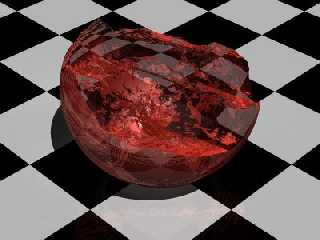I decided to try something similar, I was able to get similar results in much
much less time by using
difference{
sphere{}
isosurface{}
...
}
for one half. I tried differencing that from another sphere to get the other
half (and also scaling that sphere by 0.999 to not have coincident surface), but
it seems the isosurface is randomized somewhat at each call (I guess this is
because the isosurface has agate in it?) The broken surface uses the
Cracks(x,y,z)/4 macro from Samuel T Benge's isosurface tutorial, which contains
agate.
If I use noise3d I can matching halves, but it looks blobby rather than crisp
broken edges which one would expect from broken glass. I tried also ridged MF,
ehrm, didn't get very far :^)
Here is what I got (IIRC it took 51 minutes or so)
Post a reply to this message
Attachments:
Download 'crackedsphere.jpg' (20 KB)
Preview of image 'crackedsphere.jpg'

|




![]()